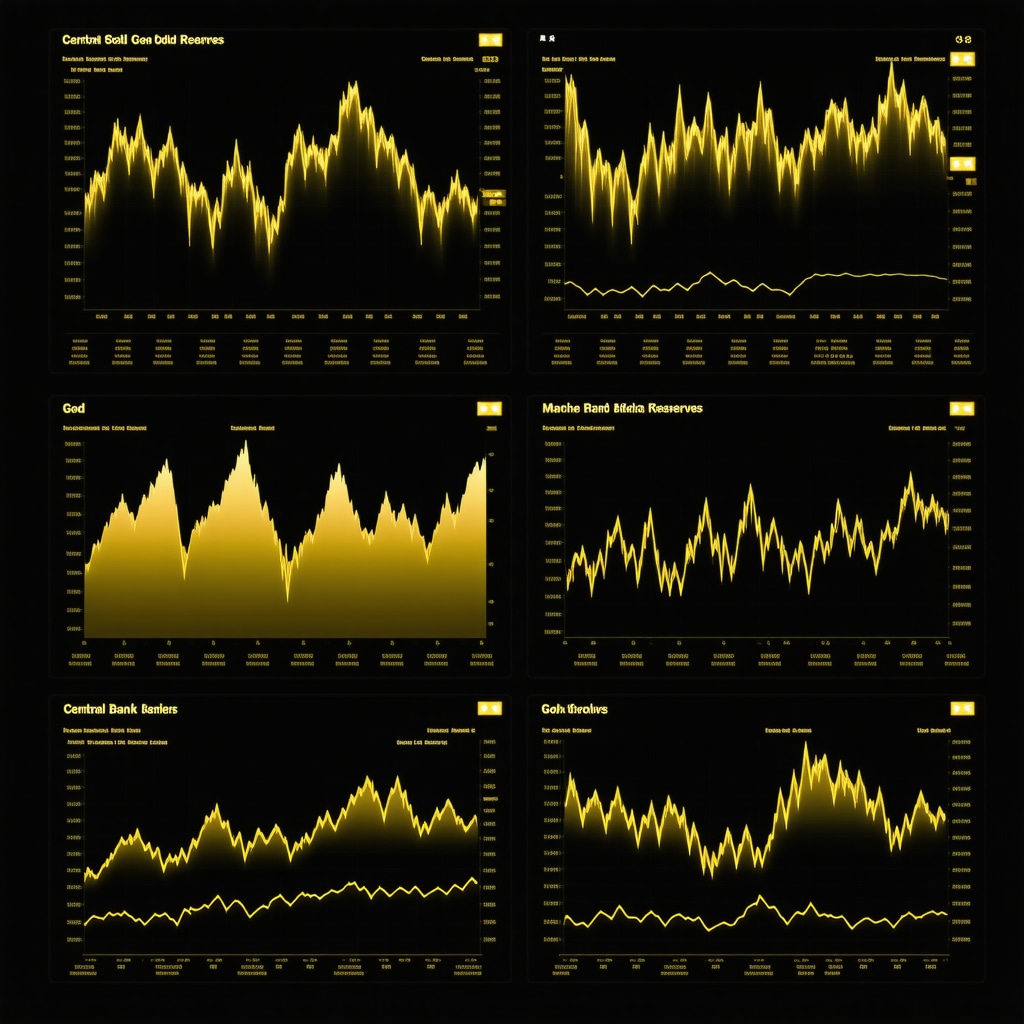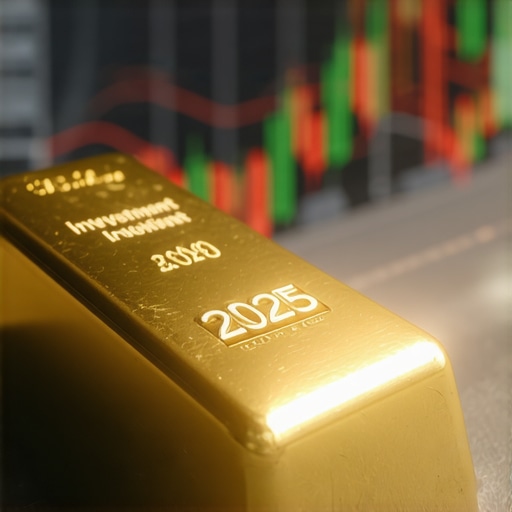Strategic Foundations of Long-Term Gold Investment
In the realm of wealth preservation and growth, gold remains a quintessential asset class, prized for its intrinsic value and resilience against macroeconomic uncertainties. Long-term gold investment strategies require a nuanced understanding of market dynamics, geopolitical influences, and evolving supply-demand fundamentals. This analytical approach transcends conventional wisdom, demanding expertise in interpreting gold’s multifaceted role as a hedge, store of value, and portfolio diversifier.
Leveraging Gold’s Supply-Demand Complexity for Sustainable Growth
Gold’s price trajectory over extended horizons is intricately linked to global supply constraints and demand vectors, ranging from jewelry fabrication and technological applications to central bank accumulation. Investors must interpret these multifactorial influences to anticipate price movements effectively. Integrating insights from detailed supply-demand trend analyses empowers investors to identify opportune entry points and mitigate risks inherent in commodity cycles.
What Advanced Portfolio Construction Techniques Optimize Long-Term Gold Returns?
Expert portfolio construction with gold involves diversifying across physical bullion, ETFs, mining stocks, and futures contracts to balance liquidity, risk, and potential appreciation. Physical gold provides tangible security but requires prudent storage solutions, whereas gold ETFs offer liquidity and ease of transaction. Incorporating gold mining equities introduces equity market exposure with potential for leverage on gold price appreciation, albeit with company-specific risks. Futures trading, while complex, can be employed for strategic hedging or amplification of returns, demanding mastery of market volatility and timing.
Integrating Inflation Hedging and Geopolitical Risk Mitigation
Long-term gold investment strategies must consider gold’s historical performance as a hedge against inflationary pressures and currency debasement. Geopolitical tensions and monetary policy shifts often catalyze demand surges, reinforcing gold’s status as a safe haven. Staying informed on geopolitical developments and central bank purchasing behaviors, as analyzed in specialized market forecasts, facilitates strategic repositioning within portfolios to capitalize on these dynamics.
Optimizing Physical Gold Holdings: Bars Versus Coins
Investors face critical decisions between acquiring gold bars or coins, each with distinct advantages and trade-offs in liquidity, premiums, and market acceptance. Bars generally offer lower premiums per ounce, appealing to large-scale investors focused on cost efficiency, while coins provide enhanced portability and potential numismatic value. Expert guidance on this selection process, such as insights from comprehensive investment resources, can significantly impact long-term wealth outcomes.
Call to Action: Deepen Your Expertise in Gold Investment Strategies
For seasoned investors aiming to refine their gold portfolio management, exploring advanced analyses and market forecasts is indispensable. Engage with our curated expert content and contribute your professional insights to foster a sophisticated discourse on maximizing gold’s potential in diversified wealth strategies.
Reference: World Gold Council. (2023). Gold Demand Trends Q4 2023. This authoritative publication provides empirical data underpinning supply and demand dynamics critical for informed investment decision-making.
Harnessing Volatility: Tactical Approaches to Gold Trading
Volatility in gold markets is often perceived as a risk, yet for adept investors, it represents an opportunity to enhance returns through strategic trading techniques. Employing methods such as swing trading, momentum analysis, and volatility arbitrage can capitalize on short-to-medium-term price fluctuations while maintaining alignment with long-term investment goals. Mastery of these techniques requires a deep understanding of technical indicators, market sentiment, and macroeconomic catalysts that drive gold price shifts. For instance, integrating insights from expert gold trading techniques can empower investors to navigate volatile periods with discipline and precision.
Evaluating Gold’s Role in a Diversified Portfolio Amid Economic Uncertainty
In an era marked by unpredictable economic cycles and geopolitical unrest, gold’s function as a portfolio diversifier and risk mitigator is increasingly critical. Quantitative portfolio optimization models frequently demonstrate that incorporating a strategically weighted allocation of gold reduces overall portfolio volatility and improves risk-adjusted returns. However, the optimal gold allocation varies based on investor risk tolerance, investment horizon, and existing asset composition. Advanced investors leverage scenario analysis and stress testing to quantify gold’s protective benefits during market downturns, thereby optimizing asset allocation dynamically.
How Can Investors Leverage Emerging Gold Demand Trends to Enhance Portfolio Resilience?
Emerging trends such as increased gold demand in technology sectors, sustainable mining practices, and shifting consumer preferences in key markets present nuanced opportunities for investors. Identifying how these evolving demand drivers influence gold’s supply-demand equilibrium can inform proactive portfolio adjustments. For example, the rising utilization of gold in electronics and green technologies may stimulate demand beyond traditional jewelry and investment sectors. Staying abreast of these developments through authoritative sources like the World Gold Council’s Gold Demand Trends report ensures that investors remain well-positioned to capitalize on structural market changes.
Strategic Storage and Security: Protecting Physical Gold Investments
Securing physical gold requires careful consideration of storage solutions that balance accessibility, security, and cost-efficiency. Options range from private vaults and bank safe deposit boxes to third-party custodial services and insured home safes. Each approach carries specific implications for liquidity, insurance coverage, and potential tax considerations. Investors should evaluate these factors in conjunction with their overall investment strategy to ensure physical gold holdings are safeguarded effectively without compromising portfolio flexibility. Expert guidance on safe gold storage practices is essential for minimizing risks associated with theft or loss.
Enhancing Portfolio Strategy Through Integrated Gold Investment Insights
For investors committed to mastering gold’s complex market dynamics, continuous education and engagement with expert analyses are vital. We encourage you to explore our comprehensive resources on gold supply and demand trends and strategic investment approaches to deepen your expertise. Share your perspectives and questions in the comments below to contribute to a rich discourse on optimizing gold investments for long-term resilience and growth.
Reference: World Gold Council. (2024). Gold Demand Trends Q1 2024. This report provides a rigorous analysis of evolving global gold demand patterns, essential for informed strategic investment decisions.
Decoding Central Bank Gold Reserves: Implications for Market Stability and Price Dynamics
Central banks play a pivotal role in shaping the gold market landscape through their strategic reserve management. Their buying and selling activities not only affect immediate liquidity but also signal broader economic intentions that can precipitate significant price movements. Understanding the nuanced motivations behind central bank gold accumulation—such as diversification away from fiat currencies, geopolitical risk hedging, and monetary policy signaling—is essential for discerning investors. For instance, recent trends indicate a resurgence in central bank purchases, particularly from emerging economies seeking to bolster financial sovereignty. The World Gold Council’s Central Bank Reserves data offers granular insights into these shifts, enabling investors to anticipate market sentiment and adjust allocations proactively.
What Are the Risks and Rewards of Leveraging Gold Derivatives in Sophisticated Portfolios?
Gold derivatives, including options and futures, afford investors the ability to tailor exposure with precision, offering both enhanced return potential and nuanced risk management capabilities. However, these instruments demand a deep understanding of leverage effects, margin requirements, and counterparty risks. While derivatives can amplify gains during bullish phases, they equally magnify losses if market timing is misjudged. Expert investors employ derivatives not merely for speculative purposes but as strategic hedges against portfolio volatility or inflationary pressures. Mastery of implied volatility metrics and the Greeks becomes indispensable in optimizing derivative positions within a diversified portfolio framework.
Incorporating ESG Considerations into Gold Investment: Navigating Ethical and Sustainability Challenges
Environmental, Social, and Governance (ESG) factors are increasingly influencing gold investment decisions, reflecting a paradigm shift toward responsible investing. The gold mining sector, historically fraught with environmental degradation and social controversies, is undergoing transformation through stricter regulatory frameworks and adoption of sustainable mining practices. Investors integrating ESG criteria seek transparent supply chains, reduced carbon footprints, and community engagement, aligning financial objectives with ethical imperatives. Advanced due diligence involves scrutinizing third-party certifications, such as the Responsible Jewellery Council (RJC) standards, and monitoring corporate disclosures to identify mining entities that reconcile profitability with sustainability.
Quantitative Modeling for Forecasting Gold Price Movements: Leveraging Machine Learning and Big Data Analytics
The advent of sophisticated computational techniques has revolutionized gold price forecasting, transcending traditional econometric models. Machine learning algorithms, including random forests and neural networks, enable the assimilation of vast datasets encompassing macroeconomic indicators, geopolitical events, market sentiment, and even social media trends to generate predictive insights. These models capture nonlinear relationships and complex interaction effects often overlooked in conventional analyses. However, the efficacy of such approaches hinges on data quality, feature engineering, and model interpretability. Integrating these advanced analytics with domain expertise fosters robust forecasting frameworks that support strategic decision-making in volatile markets.

How Can Advanced Investors Utilize Sentiment Analysis to Gain an Edge in Gold Markets?
Sentiment analysis, leveraging natural language processing (NLP) techniques on financial news, social media, and central bank communications, offers a cutting-edge tool for gauging market psychology. By quantifying bullish or bearish narratives, investors can detect shifts in collective sentiment that often precede price movements. For example, elevated positive sentiment around inflation fears might signal increased demand for gold as a hedge. Incorporating sentiment indicators alongside fundamental and technical analyses enriches the multidimensional understanding required to time market entry and exit points with enhanced precision.
Reference: World Gold Council. (2024). Central Bank Gold Reserves Data. This authoritative source provides comprehensive statistics pivotal to understanding central bank influence on gold markets.
Unveiling the Strategic Nuances of Gold Derivatives in Sophisticated Portfolios
Gold derivatives, encompassing options, futures, and swaps, represent highly specialized instruments that afford seasoned investors the ability to fine-tune exposure, hedge against volatility, and potentially amplify returns. Their deployment necessitates a profound grasp of leverage dynamics, margin requirements, and counterparty risk management. Unlike traditional bullion holdings, derivatives require active monitoring and robust risk controls, as their inherent leverage can exponentially magnify both gains and losses. Integrating derivative strategies within a multi-asset framework demands mastery of concepts such as implied volatility, the Greeks, and time decay, enabling investors to tactically position their portfolios amidst fluctuating market environments.
Ethical Imperatives: Incorporating ESG Metrics into Gold Investment Decisions
Environmental, Social, and Governance (ESG) considerations have progressively reshaped the landscape of gold investing, compelling investors to scrutinize the sustainability and social impact of mining operations. The transition towards responsible sourcing involves evaluating mining companies against rigorous ESG criteria, including carbon footprint reduction, water stewardship, labor practices, and community engagement. Certifications from bodies like the Responsible Jewellery Council (RJC) provide a benchmark for ethical compliance, yet discerning investors conduct comprehensive due diligence through sustainability reports, third-party audits, and supply chain transparency initiatives. The integration of ESG factors not only aligns with emerging regulatory frameworks but also mitigates reputational and operational risks, fostering resilient long-term investment theses.
How Can Advanced Investors Leverage Quantitative Analytics and Machine Learning to Forecast Gold Price Movements More Accurately?
Cutting-edge quantitative models utilize machine learning algorithms such as random forests, gradient boosting, and deep neural networks to process multidimensional datasets—ranging from macroeconomic indicators and geopolitical events to market sentiment and social media trends. These sophisticated approaches capture intricate nonlinear relationships and interaction effects often missed by traditional econometric models. Feature engineering, data quality, and model interpretability remain critical challenges, requiring the fusion of domain expertise with statistical rigor. Moreover, ensemble modeling and real-time data assimilation enhance predictive robustness, empowering investors to make informed, timely decisions in volatile markets.
Strategic Sentiment Analysis: Harnessing NLP for Market Psychology Insights in Gold Trading
Natural Language Processing (NLP) techniques enable investors to decode sentiment embedded within diverse textual sources such as financial news, central bank statements, and social media chatter. Advanced sentiment analysis quantifies bullish or bearish narratives, providing early warning signals of shifting market psychology that often precede price adjustments. For instance, heightened discourse around inflationary concerns or geopolitical instability can foreshadow increased gold demand. Integrating sentiment indicators with fundamental and technical analyses creates a multidimensional framework, refining entry and exit timing with enhanced precision. This approach exemplifies the convergence of behavioral finance and data science in contemporary gold investment strategies.
Engage with the Frontier of Gold Investment Expertise
For investors seeking to elevate their mastery of gold investment, embracing these advanced methodologies and ethical considerations is imperative. We invite you to explore our in-depth resources, participate in expert forums, and contribute to the evolving dialogue that shapes sophisticated portfolio management. Harness these insights to position your gold investments at the nexus of innovation, responsibility, and strategic foresight.
Reference: Responsible Jewellery Council. (2024). Responsible Jewellery Council Standards and Certification. This authoritative source delineates sustainability frameworks critical for ESG-compliant gold investments.
Expert Insights & Advanced Considerations
Integrative Portfolio Construction Enhances Risk-Adjusted Returns
Combining diverse gold investment vehicles—physical bullion, ETFs, mining equities, and derivatives—allows sophisticated investors to tailor exposure and liquidity while mitigating idiosyncratic risks. Strategic weighting across these instruments should reflect investor objectives, macroeconomic outlooks, and market signals to optimize long-term resilience and performance. For comprehensive guidance, review approaches in how to build a balanced gold portfolio with ETFs and stocks.
Sentiment Analysis as a Leading Indicator for Tactical Positioning
Natural Language Processing (NLP) techniques that quantify market sentiment from financial news, social media, and central bank communications provide early detection of shifts in investor psychology. Integrating sentiment data with fundamentals enhances timing precision for entry and exit points, especially amid volatile geopolitical or inflation-driven environments. Explore expert gold trading techniques to capitalize on these insights.
ESG Integration Strengthens Long-Term Investment Integrity
Incorporating Environmental, Social, and Governance criteria into gold investment decisions aligns portfolios with evolving regulatory frameworks and sustainability expectations. Due diligence on mining companies’ ESG practices reduces reputational and operational risks, fostering more resilient holdings. Refer to investment insights on gold coins and bars for ethical sourcing considerations.
Quantitative Analytics and Machine Learning Elevate Forecasting Accuracy
Advanced investors leverage machine learning models to synthesize complex datasets—macro indicators, geopolitical events, and sentiment metrics—capturing nonlinear price drivers often missed by traditional methods. This fusion of data science and domain expertise creates robust forecasting frameworks essential for navigating gold’s volatility. For further study, consult understanding gold supply and demand trends.
Curated Expert Resources
- World Gold Council – Gold Demand Trends: This quarterly report offers rigorous empirical data on global gold demand patterns, essential for sophisticated supply-demand analysis. (Gold Demand Trends)
- Responsible Jewellery Council Standards: A cornerstone for assessing ESG compliance in the gold mining sector, providing transparency and certification benchmarks. (Responsible Jewellery Council)
- Buying Gold Now – Central Bank Gold Buying Effects on 2025 Gold Price Forecast: Insightful analysis of central bank activity and its ramifications on gold market stability and price trajectories. (Central Bank Gold Buying Effects)
- Buying Gold Now – Gold Trading Techniques for Navigating Volatility: Tactical strategies for capitalizing on gold’s price fluctuations while aligning with long-term objectives. (Gold Trading Techniques)
- Buying Gold Now – How to Safely Store Physical Gold: Essential guidance on securing physical gold investments balancing security, liquidity, and cost. (Safe Gold Storage Practices)
Final Expert Perspective
Long-term gold investment demands a synthesis of strategic diversification, advanced analytics, and ethical considerations to navigate an increasingly complex global landscape. Integrating multidimensional insights—from supply-demand dynamics and central bank behaviors to ESG imperatives and sentiment analytics—empowers investors to construct resilient portfolios with optimized risk-adjusted returns. Embracing these expert-driven methodologies transforms gold from a mere commodity hedge into a sophisticated wealth preservation and growth instrument. We encourage you to deepen your engagement by exploring the referenced resources and contributing your professional insights to the ongoing discourse on strategic gold investment. Your expertise shapes the future of informed, responsible investing.










